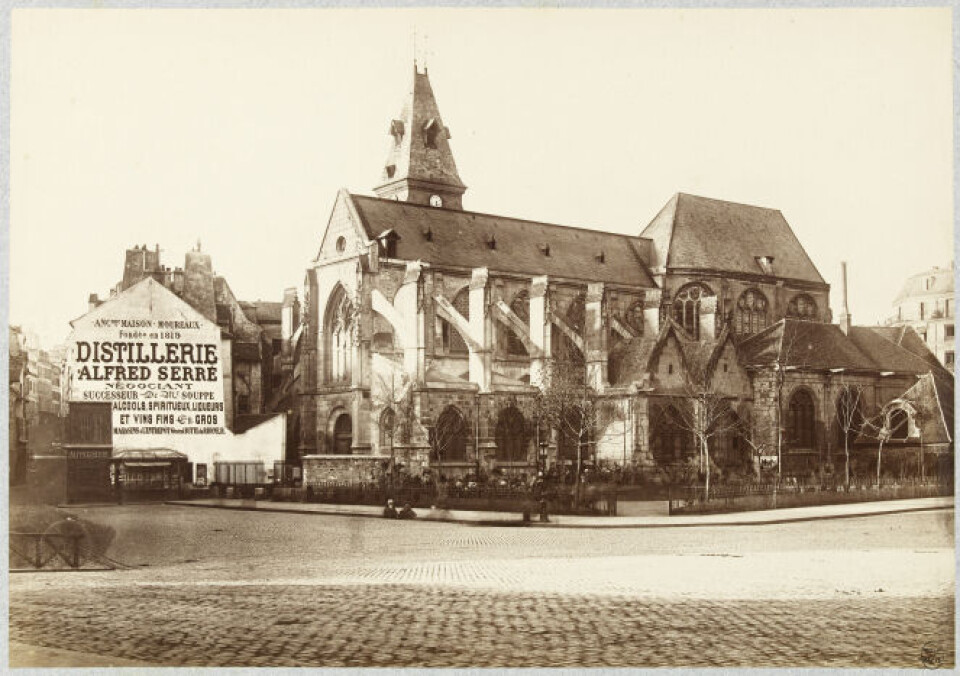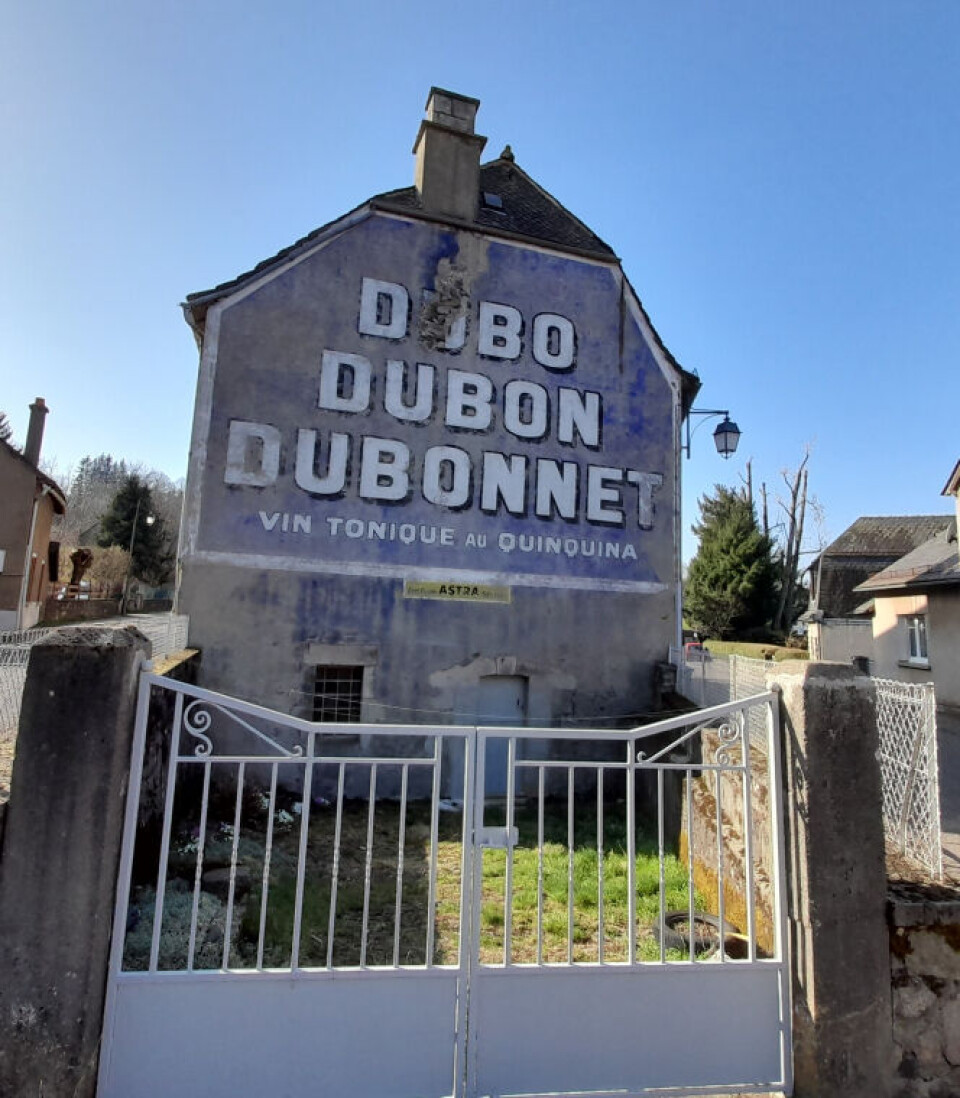-
Photos: 94 chateaux open their doors to visitors in Dordogne
The fifth Chateaux en Fête festival offers a chance to look around many impressive properties that are usually private
-
Martel: the medieval French town home to a 'truffle' train and lavender festival
The small town in the Lot offered refuge to an English throne heir until his death
-
From Cézanne to the Césars: four French art and culture recommendations
Impressionist masterpieces in Aix-en-Provence, a stylish Louvre exhibition, and a crime series to watch
Wall ads from golden age of French publicité preserved
As train travel grew from the late 1800s, advertisers discovered the potential of the bare gable walls commuters passed. Today these adverts are being preserved as works of art

Industrial innovation, economic prosperity of La Belle Epoque and growing consumerism all contributed to a blossoming partnership between art and advertising in France.
It is a collaboration that inspired advertisers and businesses to make use of ordinary gable walls – the perfect ‘canvas’ to highlight their brands to potential customers using vibrant artwork and clever slogans. Today, what remains of these ghost signs (publicité murale or mur publicitaire in French) are being recognised as pieces of art and preserved for future generations.
Read more: Trompe l’oeil homage to coastguards in Brittany wins prize
As train travel became more and more accessible in the 19th century, covering an otherwise bare wall with an advert was genius. The targets were not just passers-by on the street, but people who were now travelling further distances by rail, peering out of their windows as they chugged through towns and cities.
Other forms of réclame, or advertising, were costly and not as durable. High on a wall, there was comfort in knowing it would be robust and certainly big enough for people to see and read.
Publicité murale quickly became a victim of its own success
However, the publicité murale quickly became a victim of its own success when an increase in advertising tax around the 1870s put an end to this thriving marketing channel.
When the poster movement took off, providing artists with the freedom to express and design, art in advertising prospered once more.
Jules Chéret (1836-1932), Henri de Toulouse-Lautrec (1864-1901) and Alphonse Mucha (1860-1939) were propelled into the spotlight.
Read more: Riviera poster boy Eric Garence brings tourist hot spots to life with Art Deco flourish
During the 1920s, the publicité murale enjoyed a revival. All around France, popular brands including Dubonnet, Poulain, Byrrh, Kervoline and Lefèvre-Utile, which usually worked with renowned poster artist Firmin Bouisset (1859-1925), were using frescos to reach their audiences.
The physical task of painting the advert on the wall was the responsibility of a pignoniste – after the gable-ends, les pignons, they worked on.
Denis Breysse, author of the article L’Âge d’or des pignonistes and retired professor of civil engineering at the University of Bordeaux, said: “I think they worked mainly from a small-scale model, using the grid method reproduced on the wall (and enlarged).
“The pignonistes were more professional in painting letters. This did not prevent links with the graphic arts, but the designer of the graphics (the poster artist or painter) was not the one who painted the wall.”
Read more: French love of comic books is writ large on Angouleme walls
Innovations in advertising jostled for consumers’ attention

Soon, another stage in the evolution of advertising began as the billboard, neon and illuminated signage and TV commercials all jostled for consumers’ attention.
However, the practice of hand-painting signs still survived into the 1960s. Today, much of the original artwork on the walls has faded or disappeared. Some have fallen victim to the weather – rain and wind can take their toll over the years.
Other painted walls were damaged during conflict, or became victims of urban redevelopment.
Adding to their fragility is the fact that at the height of the publicité murale trend, one wall could be stripped and re-used several times.
Restoration efforts consider both the structural integrity of the mural and the painting itself, said Mr Breysse,
“Sometimes it is necessary to restore the support, where masonry or plastering needs repairing. This is a classic builder’s job, as the work itself has no heritage value.
“For the painting, it is a matter of being faithful to the original colours. There is no rule or standard, but my opinion is that it is important to avoid doing too much ‘new’.
“As far as time and costs are concerned, an important factor is accessibility (the height of the wall and ease of erecting scaffolding).”
Advertising murals considered to be of artistic and heritage value

Many people consider these advertising murals to be of artistic and heritage value, important artefacts that celebrate a long-gone era and provide an insight into social economics and history.
In 2012, one wall on rue des Martyrs in Paris was listed in the inventory of Monuments Historiques after the discovery of two adverts – one for Bénédictine and the other for Ripolin.
Dating back to 1908, the adverts were identified as being painted by the pignonistes Defoly (unknown) and Eugène Charles Paul Vavasseur (1863-1949).
In some cases, locals might involve the Unités départementales de l’architecture et du patrimoine (Udap), a team under the Direction régionale des affaires culturelles (Drac), which specialises in architecture and heritage and offers expertise when it comes to conservation in an urban area.
The Conservatoire des publicités extérieures et routières (Conper) is another organisation that aims to identify and preserve historic publicités murales.
In Trizac, a commune in Cantal, a faded mural on the gable end of a house is currently the subject of restoration efforts.
Its blue background has deteriorated but the lettering, while a little damaged, is still legible: “Dubo, Dubon, Dubonnet, vin tonique au quinquina.”
‘It is an advertisement from the 1930s which has marked the identity of our village ever since…’

Lionel Trazit, member of the Association trizacoise du patrimoine (ATP), whose objective is to restore heritage in the area, said: “It is an advertisement from the 1930s which has marked the identity of our village ever since. It is characteristic of the publicités murales that could be found all over France, but which have mostly disappeared.”
Cassandre, the pseudonym of Adolphe Jean-Marie Mouron (1901- 1968), was the man behind the famous Dubonnet designs, but the ATP is still awaiting confirmation of the artist, which could have been painter and decorator Giuseppe Tribus (1901-1960).
“The work will consist of repairing the unstable plasterwork and renovating this advertisement, while preserving its old appearance,” explained Mr Trazit, who has been passionate about history since his youth. He set up as an antique dealer in 1998 after studying at the Ecole du Louvre.
“After my election to the conseil municipal, I wanted to create a group with other members of the municipality dedicated to local heritage.”
The ATP was founded in 2014 and has roughly 50 members. Its work is supported by seven to eight volunteers.
“Our first goal was to financially relieve the burden of renovating the communal heritage of our village, which was then in great financial difficulty. It has been hit hard by rural desertification.”
The ATP is still in the process of gathering estimates for the mural restoration, which could cost between €5,500 and €6,000.
Funds for projects are raised through membership fees, donations, and government subsidies, but mostly through the association’s own efforts with concerts, tombolas, and publicity.
“Our approach is to preserve as much of past life and its habits and customs as we can.
“Having asked the opinion of residents, we realised that many in the village were attached to this mur publicitaire,” Mr Trazit said.
“We therefore mobilised ourselves to try to restore it. The cost will be high but I hope we will be able to save it.
Related links
‘Help us’ publicity pilots ask President Macron
France now has oldest working cinema in world dating to 1899
Proposed French law for advertising to protect environment
























